Original Article
Year: 2021 |Volume: 2 | Issue: 07 |Pages: 1-11
COMPARATIVE STUDY TO EVALUATE THE EFFECT OF SAHACHARAADI TAILA KATI BASTI AND GOKSHURAADI TAILA KATI BASTI IN THE MANAGEMENT OF VATAJA GRIDHRASI WITH SPECIAL REFERENCE TO SCIATICA.
About Author
Correspondence Address:
Dr.Vajreshwari Varanasi Siddramappa Danigond memorable trust's Ayurvedic medical college, Terdall, India Mobile no.: 89516 80795
Date of Acceptance: 2021-07-21
Date of Publication:2021-08-07
Article-ID:IJIM_79_08_21 http://ijim.co.in
Source of Support: Nil
Conflict of Interest: None Declared
How To Cite This Article: Vajreshwari V, Gurulingappa Ankad, Satish V. Comparative Study to Evaluate the Effect of Sahacharaadi Taila Kati Basti and Gokshuraadi Taila Kati Basti in The Management of Vataja Gridhrasi with special reference to Sciatica. Int. J Ind. Med. 2021;2(7):1-11
Abstract
Sciatica is the most seen neurological disorder now a days. Its more common in males than females. Objectives: To evaluate the role of Sahacharaaditaila and Gokshuraaditaila Katibasti in Vataja Gridhrasi patients. Methods: In this study, total 50 patients were taken for the trial, out of which ten patients were withdrawn. In Group A patients were advised for Kati basti is done with Sahacharaadi taila in Group B patients were advised Gokshuraadi taila Katibasti for 7days . Results & Conclusion: It is concluded that there is highly significant difference in the symptoms of Ghrudhrasi like Ruka,Toda, Sthambana, Spandana and Walking distance with intervention of Sahacharadi Tail KatibastiHowever, after comparison in both groups, we can conclude that in the symptoms i.e., Ruka,Toda, Sthambana, Spandana and Walking distance and in Parameter Straight Leg Rising Test, both tailkatibasti have found equally effective statistically.
Keywords: Ruka,Toda, Sthambana, Spandana, Sahacharaadi taila, Gokshuraadi taila
Introduction
The disease ‘Gridhrasi is Vataja and Vata – kaphajapradhana disease with the lakshanas of radiating toda from sphik, kati, prusta, uru, jangha, pada.[1 ]In Ayurveda, nomenclature of diseases has been done in different ways e.g., according to Dosha-Dushya involved, according to symptoms etc. Here, the word Gridhrasi is suggestive of the typical character of pain and the gait of the patient.[2,3] Gridhrasi is one of the nanatmaja vyaadhies it is marked as vatapradoshaja vyaadhis because vata vitiation is found as most common pathology in this disease.[4]
Sciatica is the most seen neurological disorder now a days, various treatment aspects for sciatica like NSAIDs (Non Steroidal Anti Inflammatory drugs ) or systemic steroids, administration of muscle relaxants, corticosteroids, physiotherapy gives temporary relief from pain, and Surgery is last option to treat it, but it needs long hospital stay, has several complications and may even cause permanent loss of working capabilities.[5 ]
For the present study, Sahacharaaditaila6 and Gokshuraaditaila kati[6 ] are selected, as they both are best Vata- Kaphahara. Sahacharaaditaila and Gokshuraaditaila both act as vata – hara as they possess qualities opposite to vata. Kati basti is a procedure in which both the properties of snehana and swedana are incorporated. The reason behind selection of katibasti is that it comes under direct contact with the painful site. Therefore, local snehana and swedana are very effective and give quick results because they act at the site of samprapti.
AIM AND OBJECTIVES OF THE STUDY:
- To evaluate the role of Sahacharaaditaila Katibasti in Vataja Gridhrasi patients.
- To evaluate the role of Gokshuraaditaila Katibasti in vataja gridhrasi patients.
- To compare the role of Sahacharaaditaila and Gokshuraaditaila in Vataj Gridhrasi patients.
Patients of Vataja Gridhrasi attending Panchakarma O.P.D of the Hospital were examined prior to the start of treatment with respect to the Proforma. All these values were termed as before treatment values. (B.T.) After complete examination treatment was started while patients were assigned randomly in two groups.
Group A : Kati Basti is done with Sahacharaadi taila for 7 days, once in a day, duration of 30 min.
Group B : Kati Basti is done with Gokshuraadi taila for 7 days, once in a day for the duration of 30 min. Follow up were taken after 14 days of katibasti.
INCLUSION CRITERIA:
- Subjects having radiating pain from kati to pada.
- Subjects of age group from 16-70 yrs
- Subjects fit for katibasti.
- Subjects was willing to sign the consent form.
EXCLUSION CRITERIA:
- Other systemic disorders that would disturb the study like Diabetes, CA spine etc.
- Pregnant and lactating women
- Subjects under steroids and immuno-suppressant.
" ROWS="50" class="form-control">
Methodology:
In this study, 50 patients of ‘Vataja Gridhrasi’ were taken. However, 10 patients were not coming for follow up and they dropped out. All these patients were diagnosed with the help of criteria of diagnosis. Specially designed Case Report Form (CRF) was used to record all information and medical history of Patients.Patients of Vataja Gridhrasi attending Panchakarma O.P.D of the Hospital were examined prior to the start of treatment with respect to the Proforma. All these values were termed as before treatment values. (B.T.) After complete examination treatment was started while patients were assigned randomly in two groups.
Group A : Kati Basti is done with Sahacharaadi taila for 7 days, once in a day, duration of 30 min.
Group B : Kati Basti is done with Gokshuraadi taila for 7 days, once in a day for the duration of 30 min. Follow up were taken after 14 days of katibasti.
INCLUSION CRITERIA:
- Subjects having radiating pain from kati to pada.
- Subjects of age group from 16-70 yrs
- Subjects fit for katibasti.
- Subjects was willing to sign the consent form.
EXCLUSION CRITERIA:
- Other systemic disorders that would disturb the study like Diabetes, CA spine etc.
- Pregnant and lactating women
- Subjects under steroids and immuno-suppressant.
Observations and Results:

Table No.1 Gender Wise Distribution of Patient of Vataja Gridhrasi
In this study, totally 30[75%] patients were male and 10[25%] were female while more male was recruited in study it may be due random selection of patients.
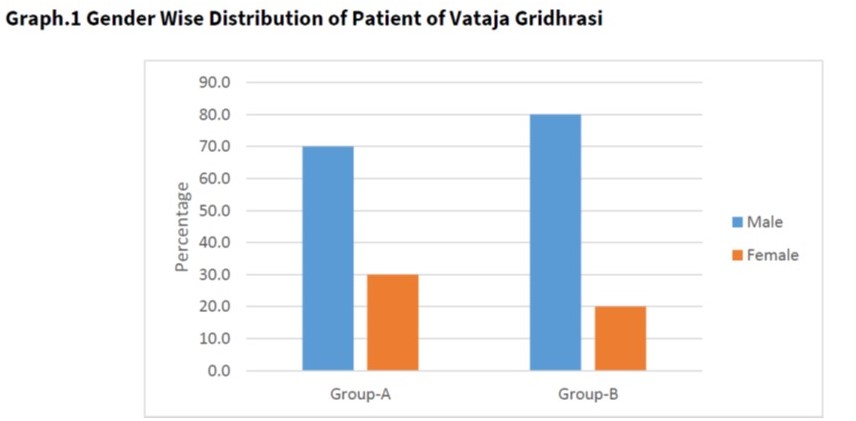
Graph.1 Gender Wise Distribution of Patient of Vataja Gridhrasi
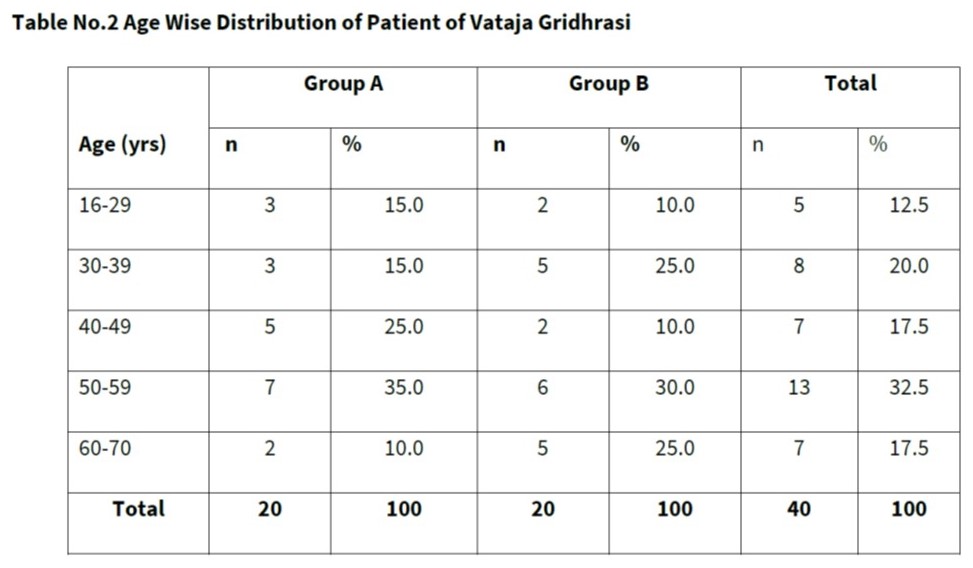
Table No.2 Age Wise Distribution of Patient of Vataja Gridhrasi
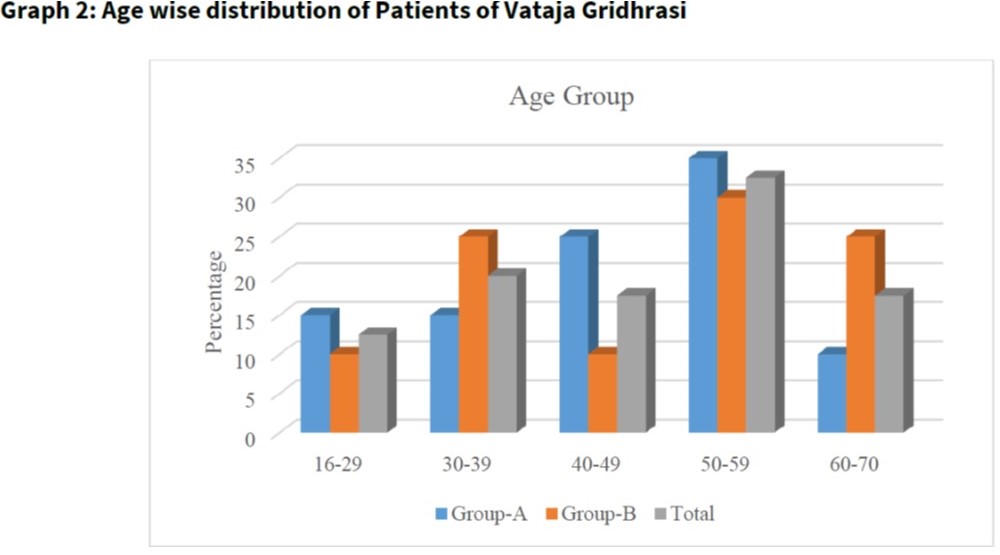
Graph 2: Age wise distribution of Patients of Vataja Gridhrasi
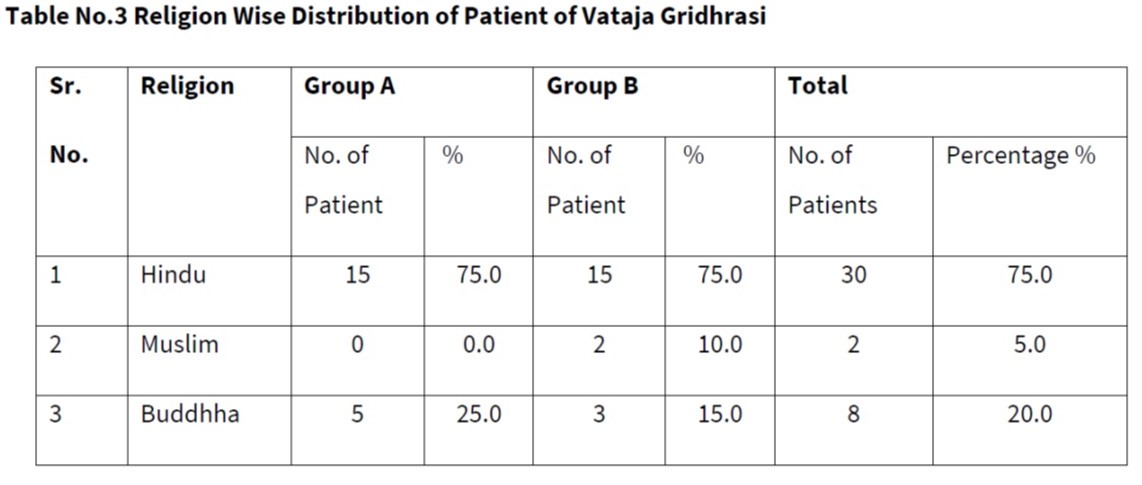
Table No.3 Religion Wise Distribution of Patient of Vataja Gridhrasi
As per inclusion criteria of patients were selected having age between 16 years to 70 yrs. and distributed it in five-sub age groups. Out of 40 patients’ number of patients found in age group 16-29 were 5[12.5%], 8[20%] patents were in age group 30 to 39 yrs, 7 [17.5%], patients were in 40 to 49 yrs. age group, 13 [32.5%] were in 50 to 59 yrs. age group while 07[17.5%] patient from age group 60-70 yrs. of Vataja Gridhrasi was observed. Out of 40 patients in the study maximum number of patients were found in Hindu religion, 30[82.5%] patients were belonging to Hindu religion, 2[5%]were from muslim and 08[20%] were from Budhha religion.
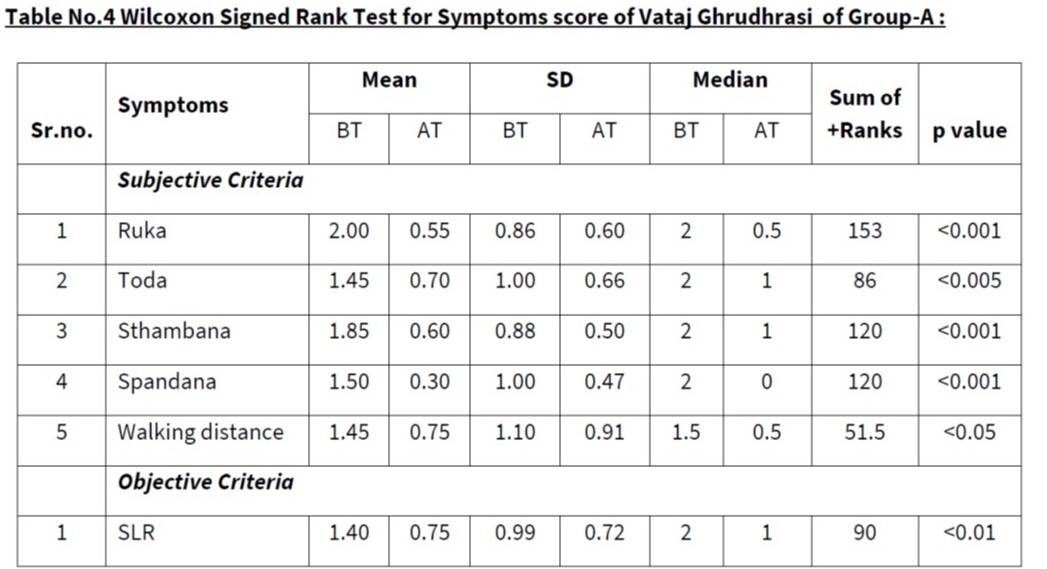
Table No.4 Wilcoxon Signed Rank Test for Symptoms score of Vataj Ghrudhrasi of Group-A :
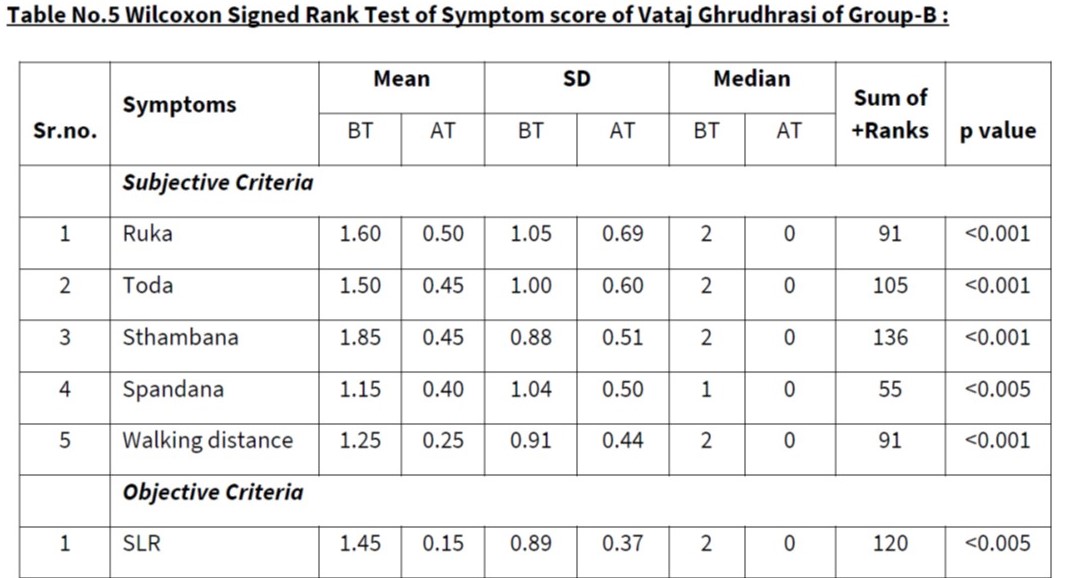
Table No.5 Wilcoxon Signed Rank Test of Symptom score of Vataj Ghrudhrasi of Group-B :
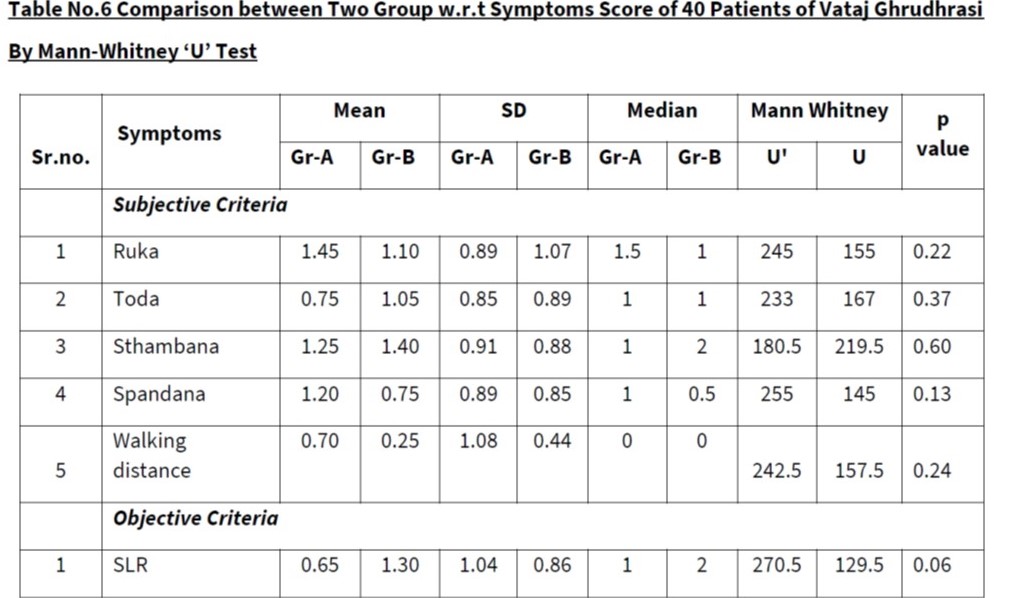
Table No.6 Comparison between Two Group w.r.t Symptoms Score of 40 Patients of Vataj Ghrudhrasi By Mann-Whitney ‘U’ Test
Percentage of Relief in Symptoms Score: (Subjective Criteria) In Group-A, percentage of relief noted in Ruka was 72.5%, while relief observed in Toda , Sthambana, Spandana, walking distance and SLR it was 51.7%, 67.6%, 80%, 48.3%, and 46.4 % respectively. In Group-B, percentage of relief observed in Ruka was 68.8%, while relief observed in Toda, Sthambana, Spandana, walking distance and SLR it was 70,%, 75.7%, 65.2%, 80% and 89.7 % respectively. Average relief observed in Group-A in was 61.1% while average relief observed in Group -B in was 74.9%.
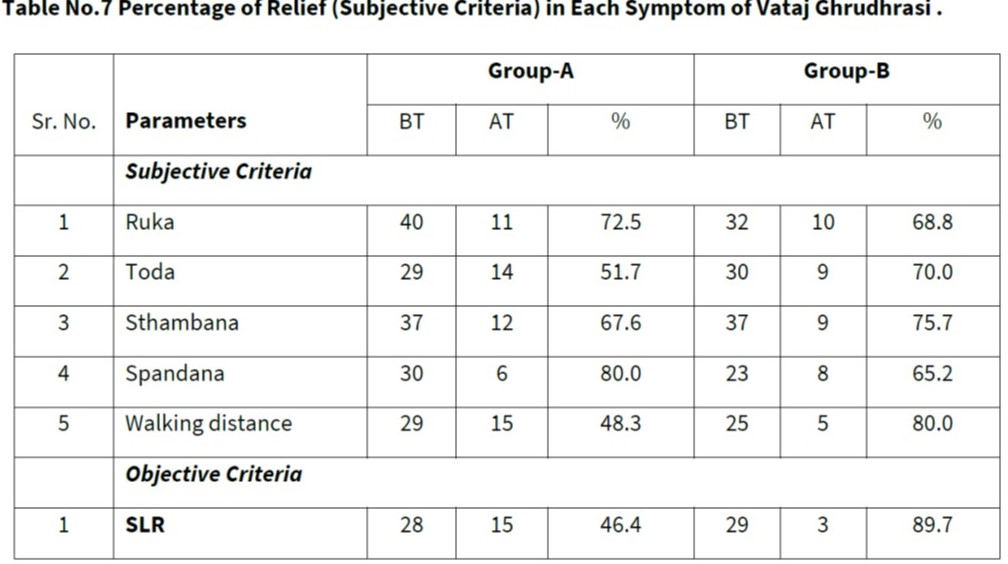
Table No.7 Percentage of Relief (Subjective Criteria) in Each Symptom of Vataj Ghrudhrasi
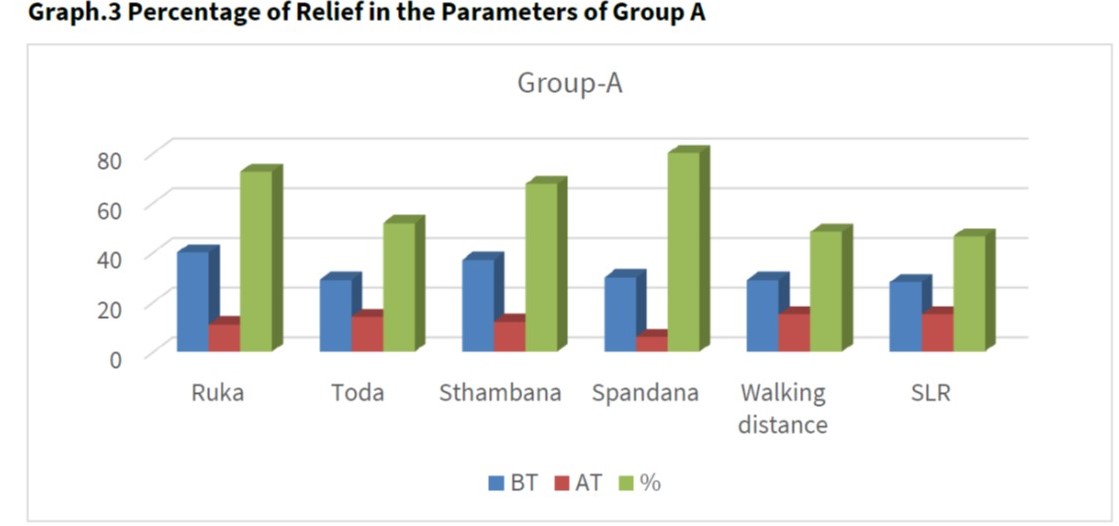
Graph.3 Percentage of Relief in the Parameters of Group A
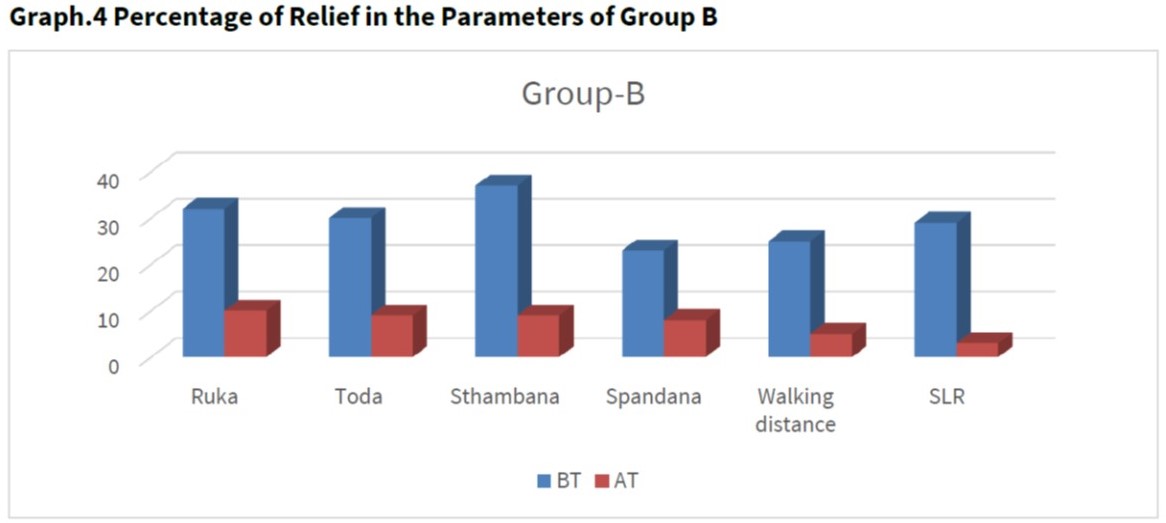
Graph.4 Percentage of Relief in the Parameters of Group B
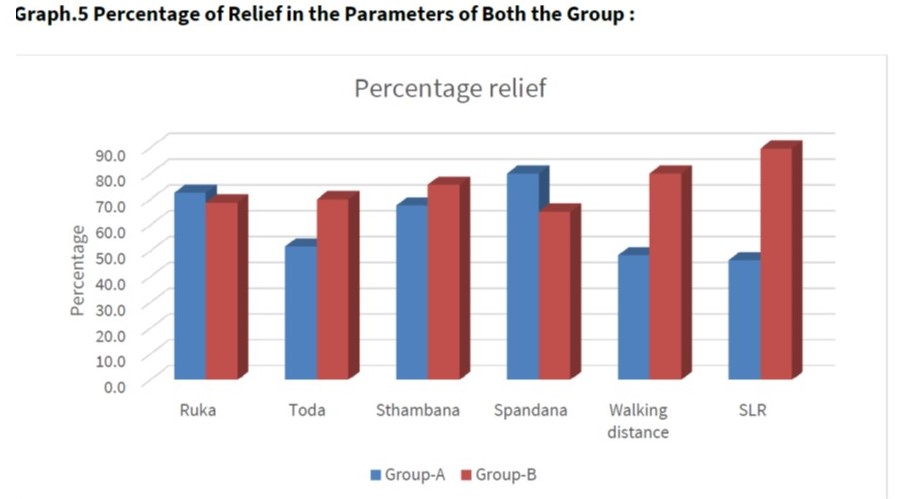
Graph.5 Percentage of Relief in the Parameters of Both the Group :
Effect of Therapy on Symptoms of Vataj Ghrudhrasi in Group-A Statistically:-
- Subjective criteria:
It was observed that, In Group-A, regarding symptom Ruka, Toda, Sthambana, Spandana and walking distance the difference in the score for before treatment and after treatment was statistically highly significant (p<0.001). So, it is concluded that there is highly significant difference in the symptoms of Ghrudhrasi with intervention of Sahacharadi Tail Katibasti.
- Objective Criteria:
In parameter, Straight Leg Rising (SLR), the Mean ± SD value obtained Before Treatment (BT) was 1.40±0.99 and After Treatment (AT) it was changed as 0.75± 0.72 which was statistically highly significant (p<0.01).
Effect of Therapy on Symptoms of Vataj Ghrudhrasi in Group-B Statistically: -
- Subjective criteria:
Similarly, it was observed in Group-B, regarding symptom Ruka, Toda, Sthambana, Spandana and walking distance the difference in the score for before treatment and after treatment was statistically highly significant (p<0.001). So, it is concluded that there is highly significant difference in the symptoms of Ghrudhrasi with intervention of Gokshuradi tail Katibasti.
- Objective Criteria:
In parameter, Straight Leg Rising (SLR), the Mean ± SD value obtained Before Treatment (BT) was 1.45±0.89 and After Treatment (AT) it was changed as 0.15± 0.37 which was statistically highly significant (p<0.001).
Comparison between Two Group w.r.t Symptoms of Vataj Ghrudhrasi :
In Group A for the parameter, Straight Leg Rising (SLR), before treatment and after treatment score, there was significant difference which was statistically highly significant (p<0.01). In Group B, for the parameter, Straight Leg Rising (SLR), before treatment and after treatment score, there was significant difference which was statistically highly significant (p<0.01). The Difference between before treatment and after treatment score of both groups compared by ‘Mann-Whitney U Test’. It was found that the difference between Symptom Score of Ruka of Group-A and Group-B is statistically not significant, so therefore we can conclude that in the symptom Ruka, both groups were equally effective.
In symptoms Toda, Sthambana, Spandana and Walking distance p value obtained is >0.05 where test statistic U value was not lies between Population Mean ±1.96 SD which shows the difference was not significant, so therefore we can conclude that in these symptoms i.e. Ruka,Toda, Sthambana, Spandana and Walking distance and in Parameter Straight Leg Rising Test, both drug have found equally effective statistically.
Discussion
In this study, totally 30[75%] patients were male and 10[25%] were female while more male was recruited in study it may be due random selection of patients. Out of 40 patients’ number of patients found in age group 16-29 were 5[12.5%], 8[20%] patents were in age group 30 to 39 years, 7 [17.5%], patients were in 40 to 49 yrs. age group, 13 [32.5%] were in 50 to 59 yrs. age group while 07[17.5%] patient from age group 60-70 yrs. of Vataja Gridhrasi was observed. In this study, out of 40 patients 04[10%] were having Habit of Tobacco, 24[60%] having Habit of tea, 03[7.5%] were having Habit of smoking, 03[7.5%] were alcoholic while 06[15%] having no any Habit.
It was observed that, In Group-A, regarding symptom Ruka, Toda, Sthambana, Spandana and walking distance the difference in the score for before treatment and after treatment was statistically highly significant (p<0.001). So, it is concluded that there is highly significant difference in the symptoms of Ghrudhrasi with intervention of Sahacharadi Tail Katibasti.
Similarly, it was observed in Group-B, regarding symptom Ruka, Toda, Sthambana, Spandana and walking distance the difference in the score for before treatment and after treatment was statistically highly significant (p<0.001). So, it is concluded that there is highly significant difference in the symptoms of Ghrudhrasi with intervention of Gokshuradi tail Katibasti.
Probable mode of action of Katibasti:
Kati Basti given in both the group with Sahacharaadi taila and Gokshuraadi taila in Group-A and Group-B respectively for 7 days. This Katibasti for the seven-day implementation is resulting in relaxation of mamsa dhatu, and its further strengthen later dhatu like asthi, majja, shukra and it raise the bala of all dhatu thus revived pain and nourishes local tissue too. Katibasti of medicated tail helps to relieves pain in the low back and lower limbs relieves stiffness in the low back and lower limb, relieves swelling and inflammation in the low back, in the bones and soft tissues of the low back, Due to improved blood circulation it brings lightness and a sense of health in the lower portion of the body, improves movements at the back and lower limbs and enable us to move and work freely, Strengthens the low back (bones, muscles and soft tissues therein), Soothes the nerves supplying the low back and legs (lower limbs), Enhances blood supply to the low back area.
Kati Basti of both the tail were found to be effective in relieving pain, stiffness and swelling associated with Sciatica, pacifies the morbidity of Vata, Pitta and Kapha in the affected joints, muscles and soft tissues. Kati Basti is highly effective in the pain, Toda and stambhata of Ghrudhrasi.
Scope of study:
Further large study can be done on more sample to generalize the results. Study can also be done with addition of any like Panchakrama to obtain more efficacy of procedure.
Limitations of study:
Small size of sample, single therapy .
Conclusion
Conclusion
It is concluded that there is highly significant difference in the symptoms of Ghrudhrasi like Ruka,Toda, Sthambana, Spandana and Walking distance with intervention of Sahacharadi Tail Katibasti. Similarly there is significant difference after treatment in the symptoms of Ghrudhrasi like Ruka,Toda, Sthambana, Spandana and Walking distance with intervention of gokshuradi Tail Katibasti.
In Group A and Group B, for the parameter, Straight Leg Rising (SLR), before treatment and after treatment score, there was significant difference observed.
However, after comparison in both groups, we can conclude that in the symptoms i.e., Ruka,Toda, Sthambana, Spandana and Walking distance and in Parameter Straight Leg Rising Test, both tailkatibasti have found equally effective statistically.
References
value="
- Agnivesh, Charaka, Dridabala, Charakasamhita ,Sutrasthana , Chapter 16th/ 20, edited by Yadavji Trikamji Acharya and Narayanaramacharya, kavyatirta publishers – chaukambhaorientalia- reprint 2010. page no - 97 ,
- Shushruta ,Shushrutasamhita, Nidanasthana, 1stchapter, 74thshloka, Page No- 268, Vatavyaadhi Edited by Yadavajitrikamji Acharya- Varanasi - chaukambaorientalia.
- Vagbhata, Astangahridayam, Nidanasthana 15th chapter/56 ,vatavyaadhinidana, page no-535, commentary with Arunadatta and edited by Pt. Bhigacharya, Harishastriparadkar, Varanasi- Krishnadas Academy: reprint 2000.
- Agnivesha, Charaka, Dridabala, Charakasamhita ,Sutrasthana, 16th chapter/20 shloka, page number 97 edited by yadavjitrikamji Acharya and narayanaramacharya, chaukambaorientalia: reprint 2000
- Sir Davidson , Davidson’s principles and Practice of medicine , edited by Nicolas John A A. Hunter 20th edition Elsevier limitrd : 2006 Pno. 1242.
- Vangasena, Vangasenasamhita, Chikitsasarasamgraha, Vatavyaadhi Chikitsaadhyaya, Varanasi Chaukambaorientalia 2003 p.168
"

